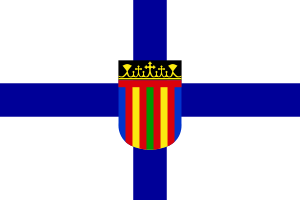Copts in Libya
| Regions with significant populations | |
|---|---|
| 60,000[1] | |
| Languages | |
|
Arabic Liturgical: Coptic language | |
| Religion | |
| Coptic Christianity |
Copts in Libya may refer to people born in or residing in Libya of full or partial Coptic origin.
The largest Christian group in Libya is the Coptic Orthodox Church, with a population of 60,000.[2] The Coptic Church is known to have historical roots in Libya long before the Arabs advanced westward from Egypt into Libya.
History
Historically speaking, Christianity spread to the Pentapolis in North Africa from Egypt;[3] Synesius of Cyrene (370-414), bishop of Ptolemais, received his instruction at Alexandria in both the Catechetical School and the Museion, and he entertained a great deal of reverence and affection for Hypatia, the last pagan Neoplatonists, whose classes he had attended. Synesius was raised to the episcopate by Theophilus, patriarch of Alexandria, in 410. Since the Council of Nicaea in 325, Cyrenaica had been recognized as an ecclesiastical province of the See of Alexandria, in accordance with the ruling of the Nicaean Fathers. The Pope of Alexandria to this day includes the Pentapolis in his title as an area within his jurisdiction.[4]
The Coptic congregations in several countries were under the ancient Eparchy of the Western Pentapolis, which was part of the Coptic Orthodox Church for centuries until the thirteenth century.[5]
In 1971 Pope Shenouda III reinstated it as part of the Eparchy of Metropolitan Bishop Pachomius, Metropolitan of the Holy Metropolis of Beheira (Thmuis & Hermopolis Parva), (Buto), Mariout (Mareotis), Marsa Matruh (Paraetonium), (Apis), Patriarchal Exarch of the Ancient Metropolis of Libya: (Livis, Marmarica, Darnis & Tripolitania) & Titular Metropolitan Archbishop of the Great and Ancient Metropolis of Pentapolis: (Cyren), (Appollonia), (Ptolemais), (Berenice) and (Arsinoe).
This was one among a chain of many restructuring of several eparchies by Pope Shenouda III, while some of them were incorporated into the jurisdiction of others, especially those who were within an uncovered region or which were part of a Metropolis that became extinct, or by dividing large eparchies into smaller more manageable eparchies. This was also a part of the restructuring of the Church as a whole.
They are currently three Coptic Orthodox Churches in Libya: one in Tripoli, Libya (Saint Mark's), one in Benghazi, Libya (Saint Antonios — two priests), and one in Misrata, Libya (Saint Mary and Saint George).[6]
Currently, there are 60,000 Copts in Libya, as they have many roots in North Africa (primarily Egypt).[2]
Anti-Coptic sentiment in Libya
In February 2014, east of Benghazi, seven Coptic Christians were dragged out of their houses in the middle of the night, shot in the head execution-style, and killed.[7]
On January 12, 2015, twenty-one Coptic Christians were abducted by forces of the Islamic State of Iraq and the Levant.[8] On February 15, 2015 those twenty-one Christians were executed by Islamic State of Iraq and the Levant Shown in a video "A Message Signed with Blood to the Nation of the Cross."
See also
- Coptic diaspora
- Christianity in Libya
- Copts in Egypt
- Copts in Sudan
References
- ↑ Looklex Encyclopedia: 1% of Libya's population (6 million), or 60,000 people in Libya, adhere to the Coptic Orthodox faith
- ↑ 2.0 2.1 Looklex Encyclopedia: 1% of Libya's population (6 million), or 60,000 people in Libya, adhere to the Coptic Orthodox faith
- ↑ Britannica
- ↑ Coptic.net
- ↑ History of the Coptic Church, by Father Menassa Youhanna
- ↑ Coptic Orthodox Church Listings for Libya (P. 136)
- ↑ Seven Egyptian Christians found shot execution-style on Libyan beach
- ↑ "ISIS claim abduction of 21 Christians in Libya: activists". Agence France Presse (Daily Star Lebanon). January 12, 2015.
| ||||||||||||
